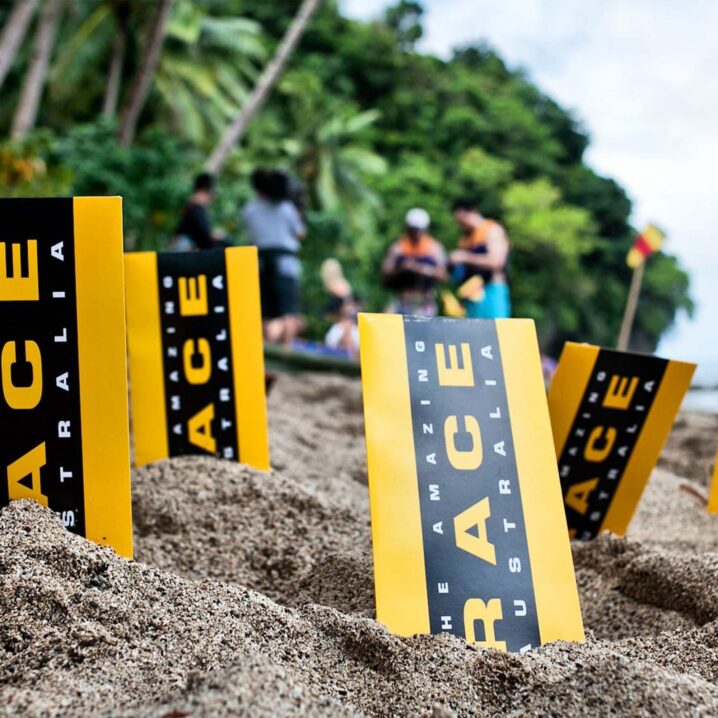
- POPSUGAR Australia
- Celebrity
- Rule Over “The Amazing Race” With These “Amazing Race” Rules
Rule Over “The Amazing Race” With These “Amazing Race” Rules

“The Amazing Race Australia” is back, with 11 celebrity teams racing around four countries. They’ll be adventuring across India, Malaysia, Cambodia, and Borneo. However, “The Amazing Race Australia” is infamous for having a lot of rules, some of which might daunt your boomer father.
According to Beau Ryan, the host of “The Amazing Race”, this year’s contestants are taking the rules super seriously.
“I didn’t realise they’d be that invested, but they are,” said Ryan in a phone call with “The Latch”. “People just really find another level to try and win the show and raise money for charity.”
So, what are the rules that are amping up this season? Are they rules that your dad can easily understand? Let’s learn the facts you need to know.
“The Amazing Race” Rules Terminology
“The Amazing Race” and its rules are mythic and full of meaning. To understand this series, you’ll need to understand the following terms.
Pit Start
A pit start is the starting line that each team begins at. Each section of “The Amazing Race” has a pit start.
Pit Stop
A pit stop is a finish line that denotes the end of a section. Typically, the final team to check into a Pit Stop is eliminated.
Route Markers
Route Markers are yellow and red flags that guide the teams during some challenges.
Clues
Clues are the little envelopes of information that give each team instructions on how to proceed during a leg of the race.
Leg Money
Leg Money is the cash each team is given to assist them in getting around when attempting to complete their tasks. Any Leg Money that is leftover from one section rolls over to the next section.
Active Route Marker
Active Route Markers are challenges both team members must participate in together.
Roadblock
Roadblocks are challenges that only one team member can undertake.
Detour
Detours are a series of two challenges. However, with Detours, each team only has to choose and complete one of these tasks.
U-Turn
U-Turns are punishment some teams can play. If you receive a U-Turn, you must complete two Detour challenges.
Fast-Forward
Fast-Forwards are a power-up that some team can win. If you use a Fast-Forward, you can skip some challenges and go straight to the Pit Stop.
Intersection
Intersections are tasks that two or more teams must collaborate to compete. If no other team is present when the first team arrives at an Intersection, they must wait for one to arrive.
Salvage
Salvages are advantages that some teams win. In previous seasons of “The Amazing Race”, Salvages have included personal drivers, extra money, and secret information.
Sabotage
Sabotages are a disadvantage that some teams are hit with. In previous seasons of “The Amazing Race”, Sabotages have resulted in some teams losing all their money and having to compete while not wearing shoes.
How All “The Amazing Race” Rules Work in Tandem
Okay, now that we all know “The Amazing Race” terminology, let’s unpack how a typical episode works.
In “The Amazing Race”, each team begins at the Pit Start. They then race, being guided by Route Markers and Clues.
If they need to get somewhere quickly, they can use their Leg Money to do so.
During this race, each team will come against Active Route Markers, Roadblocks, and Intersections. These teams must complete these challenges before they move on.
Some teams will be slowed down by Detours, U-Turns, and Sabotages. Meanwhile, other teams will go faster thanks to Fast-Forwards and Salvages.
The first team to get to the Pit Stop is the winner.
“The Amazing Race Australia” airs at 7.30pm on Wednesdays and Thursdays, only 10 and 10 Play on Demand. Miss an episode? Catch up on 10 Play.
This article was originally published on The Latch. Click here to read the original.
Want more “The Amazing Race” goss? Go through the articles below:
- Everything You Should Know About “The Amazing Race Australia: Celebrity Edition”
- Meet the Cast of “The Amazing Race Australia: Celebrity Edition”
- King George and His Sister Are Bringing “Survivor” Tactics to “The Amazing Race” 2023
- Heath and Toni Have Been Crowned the Winners of The Amazing Race Australia 2022!
- Beau Ryan Opens Up About What The Amazing Race Australia Has Taught Him
- Before You Watch The Amazing Race, Let’s Discuss the Rules of the Game
- Alli Simpson and Angie Simpson: The Daughter-Mum Duo Racing on “The Amazing Race”
- Bec Judd and Kate Twigley — Will These Sisters Crush “The Amazing Race” Competition?
- “The Amazing Race” 2023: Grant Denyer and Wife, Chezzi Are Heating Up the Competition
- Ben and Jackie Gillies: A Power Couple Ready to Crush “The Amazing Race”
- The Important Reason Why Dane and Bow Simpson Are on “The Amazing Race”
- Meet Harry Jowsey and Teddy Briggs, the Mates Giving “The Amazing Race” Their All
- Peter and Frankie Rowsthorn Are Bringing Giggles and Quips to “The Amazing Race” 2023
- Go for Gold: Jana Pittman and Her Son, Cornelis Are Taking on “The Amazing Race”

